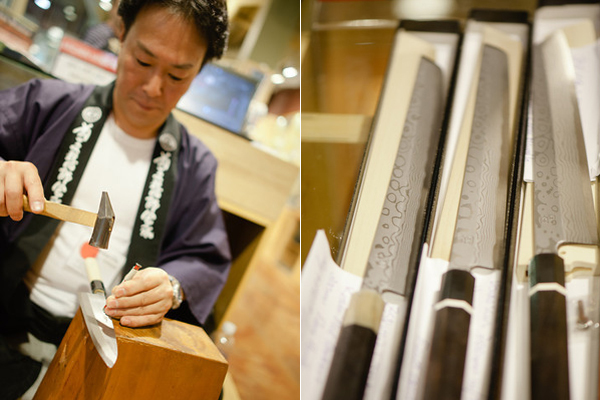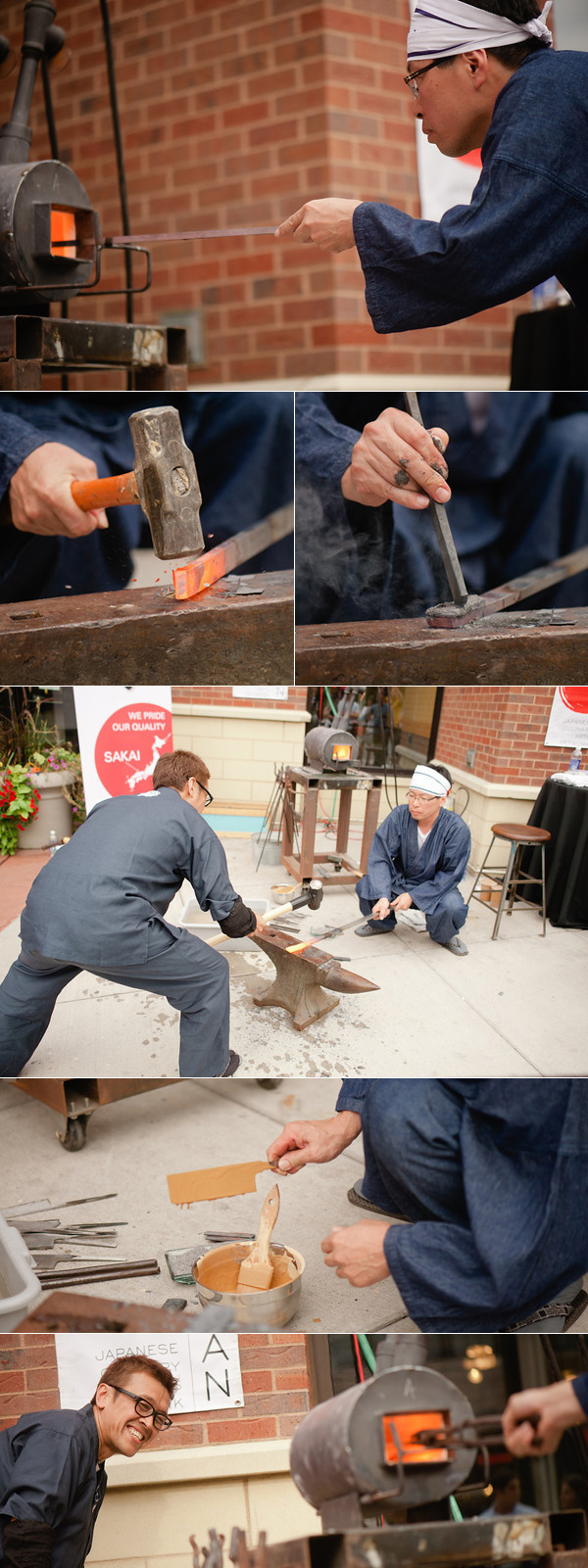
It’s one thing to understand abstractly that a knife can be a beautiful thing, lodged confidently at the intersection of “art,” “craft,” and “tool.” It’s another entirely to see craftsmen breathing life into one before your eyes, leaving smoke, flying metal, and the ringing of hammers in their wake.
Last night in Uptown, a small crowd gathered at Kitchen Window to watch a team of craftsmen from Sakai, Japan, demonstrate several of the most dramatic steps of knife forging. The men (knife forgers Tadashi Enami and Yuzo Tani, and assembler / engraving expert Akimasa Oe) work for Kikuichi Cutlery, and are on a nine-city tour sponsored by the Japanese Culinary Arts Network. JCAN president Harry Rosenblum (pictured bottom, left) acted as emcee for the event, and Kikuichi New York’s president, Ikuyo Yanagisawa (bottom, right), spoke about the company’s 700-year history and 19th century transition from katanas to kitchen knives.

Kikuichi knives typically cost hundreds of dollars (Kitchen Window sells them, and was offering free engraving and a discount to celebrate the forging event). It’s a sum that might seem ridiculous for a single piece of kitchen equipment until you lay eyes on the things and consider the literal sweat that goes into their creation; the company makes one or two dozen knives a day, not hundreds, or thousands.

Enami (left) and Tani (right, with headband) began the demonstration by scraping the carbon off of a red-hot piece of metal. The next step of the demonstration was a bit more dramatic: the joining of soft and high carbon steel, to make up the bulk of the blade and its sharp, durable edge, respectively. Spectators were invited to join in during the “hitting the 1500-degree metal with a sledgehammer” portion of the event, which was pleasantly free of injuries or metal-related secondary fires.
Skipping ahead in the forging process, the craftsmen used a wet layer of clay to coat the blade for even heating during a rehardening and quenching sequence that tempered the material, leaving it strong but brittle and ready for polishing.

Oe, above, pushed the heated knife into the handle with the aid of a mallet. There it burned its way into a firm fit with the material — smoke gushed forth from the knife like the conclusion of a magician’s trick. After the handle insertion, he sighted the knife on a device that both straightened the blade and confirmed a clean fit. Oe acts as the company’s final quality control point, and he is also able to quickly and skillfully custom engrave knives with the rapid tapping of a simple straight chisel.
The overall impact of the demonstration was craftsmanship as theater, and theater as art. It’s enough to make you want to buy a kitchen knife that moonlights as art.


Urgh! I had this on my calendar for next week! Thanks for the photos and the commentary … really wish I wrote down the right date.
Outstanding photos as always!
It was really amazing watching the master craftsmen at work. The exquisite knives they produce are not only beautiful and functional, but so precise in their execution – it’s hard to believe they were made by hand.
(I’m so glad you two could make it to our event, great write-up and photos as usual!)
This shows just how to turn what we often see as just a ‘functional tool’ into something of real beauty. Amazing craftsmanship.
Would have been nice to have gone into a little more detail what steels they were using (I’d assume White or Blue for the cutting edge on the San Mai blade) and why.
I’d also be careful using Japanese blades on American tasks as they are typically much harder than what most americans are used to using and will chip if used incorrectly